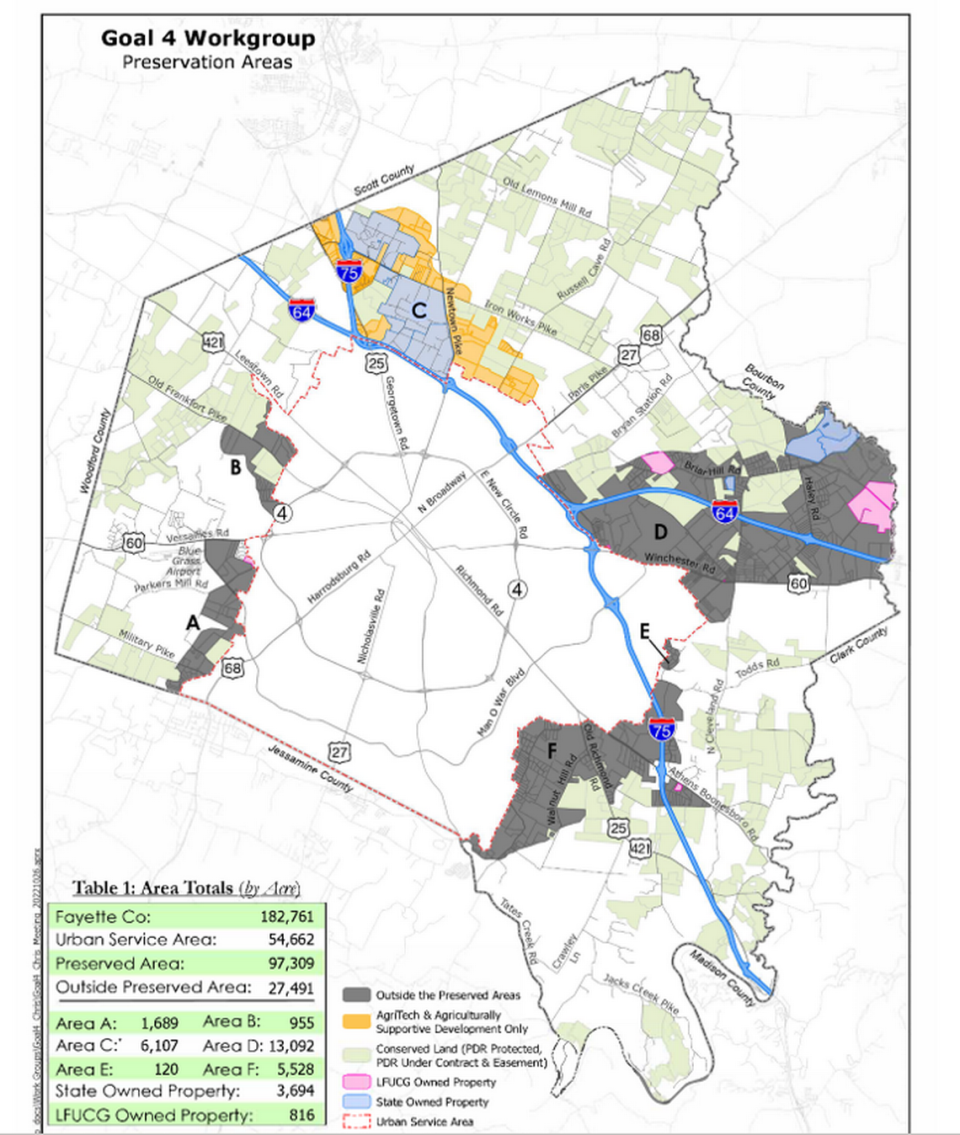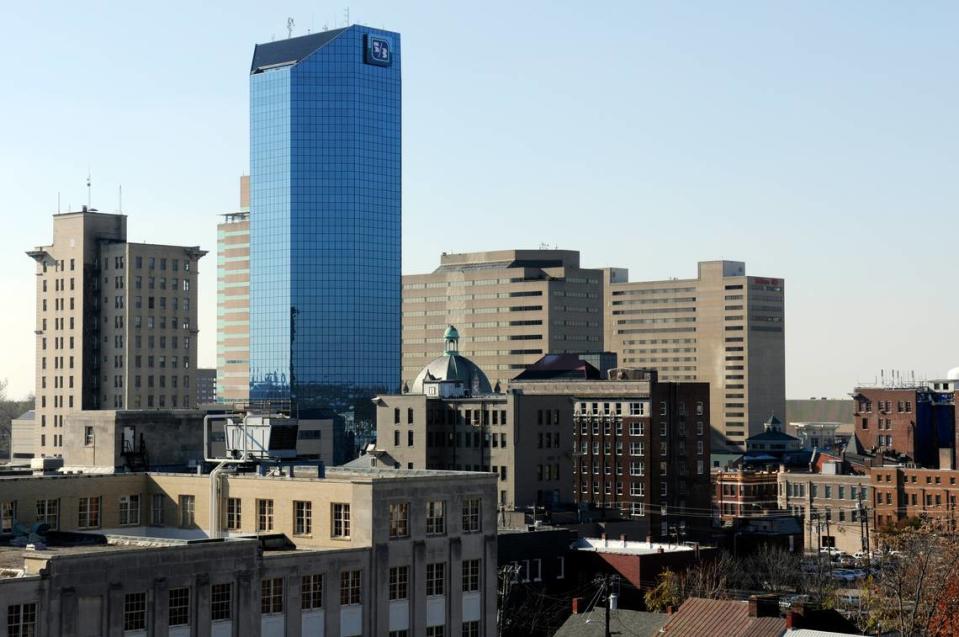Lexington’s urban service area needs 5,000 more acres, group says. Why some are opposed
A group of business leaders want the Lexington-Fayette Urban County Council to add up to 5,000 acres of land to the city’s urban area.
The city has not expanded its urban service boundary, which determines where development can go, since 1996, when more than 5,000 acres was added.
“In recent years, Lexington has lost 1,500 jobs to surrounding counties with another 1,000+ in jeopardy of leaving due to a lack of available land for business expansion,” wrote the group in a letter to the council.
Those job numbers came from Commerce Lexington, an area business group.
The letter and the demands of the group were presented to the council during a Tuesday meeting designed for the public to weigh in on the 2045 Comprehensive Plan, which guides development over the next five years.
More than 30 people spoke about various parts of the comprehensive plan during a nearly three-hour long meeting.
While many in the business and development community pushed for more land to be added to the boundary, many agricultural stakeholders urged the city to take time to develop a sustainable, data-driven plan to add more acreage for development.
The council is expected to take a final vote on the 2045 Comprehensive Plan in the coming weeks.

The bulk of the city’s budget is funded through occupational taxes, or a tax on jobs.
Without more jobs, the city could be facing a potential revenue shortfall in coming years, the group argued. Moreover, home prices and rents are skyrocketing, many said during Tuesday’s meeting.
Those signing the letter include: Ray Daniels, board chair Lexington for Everyone, a group formed to lobby for the expansion of the urban service area; Bob Quick, president of Commerce Lexington, the local chamber of commerce; and Todd Johnson, executive vice president of the Building Industry Association of Central Kentucky.
“No one in the business community will allow for the destruction of what makes Lexington special,” Quick said during Tuesday’s meeting. “There is a less than four percent of vacant, developable land inside the urban service area. We are at a tipping point. We have not been providing enough land for housing or jobs.”
At issue is a part of the plan that lays out a data-driven approach to determine if and when the city should expand. The city set up two groups — the Sustainable Growth Task Force and the Goal 4 work group — to develop a matrix to determine when the city needed more land and a map for areas that should be protected and areas that could be developed, if and when the boundary is expanded.
The current draft of the plan does not incorporate those two groups’ work. Instead, the plan says the city should “build” on the work of the two plans and then adopt those studies, when completed, as an amendment to the comprehensive plan.
Under the Goal 4 report, discussions about whether to expand the boundary would not begin until 2026.
That’s a long time from now, advocates for expansion told the council Tuesday.
The group wants the city to allow property owners along the Winchester and Athens Boonesboro roads corridor to petition to put up to 5,000 acres of land inside the boundary.
Quick argued the area of Winchester and Athens Boonesboro roads has sewer access and is ripe for expansion.
The Goal 4 report included those areas for possible expansion if and when the city decides to expand the boundary.
Carla Blanton, of Lexington for Everyone, said, the city has enough data. It’s time to act, she said.
“More study is not about data, it’s about delay,” Blanton said.
Others said the city is already losing jobs.
Gina Greathouse, of Commerce Lexington, said site selectors for companies know Fayette County is out of land. They aren’t coming here, she said. Moreover, other Lexington-based companies have moved because they can’t expand.
Fayette Electric, for example, has moved to Clark County, she said.
Rob Shear, of SRC of Lexington, a machine manufacturing company, said the company has looked for years for property but it can’t find an industrial and warehouse space large enough to expand. Meanwhile, land in nearby counties such as Clark and Woodford counties is much, much cheaper.
Shear said he would like to keep his employees in Fayette County but without available industrial land to expand, that may be impossible, he said.
Take time to plan for growth
Judy Worth, a planning commission member and member of the Goal 4 group, said the group did not recommend expansion of the 5,000 acres around Winchester and Athens Boonesboro roads. The report was only a recommendation of areas that could be expanded. The report also looked at areas that should be protected.
“The report says just because a property appears on that map does not mean it’s ready for development,” Worth said. Worth said the Goal 4 group developed an extensive process to determine if and when a property should be added to the urban service area.
That’s what the council should look at, she said.
Former Vice Mayor Steve Kay, who served as co-chair of the Goal 4 work group, echoed Worth. The Goal 4 report has an extensive process for adding acreage to the urban service boundary.
Kay said the Lexington for Everyone proposal of bringing in 5,000 acres without planning mirrors the 1996 expansion.
“Most people would agree the last expansion has not worked out that well,” Kay said. More than half of that land is still available for a variety of reasons, he said.
The council could recommend the city start debates about whether it should open the boundary but follow the guidelines set forth in the Goal 4 report. To add land to the urban service area, an applicant must show there is a specific need for that land. It also must go through a zone change process, which is public, he said.

‘No farms. No Food.’
Others said once farmland is developed, it’s gone. The city needs to focus on compact development to combat climate change.
Anthony Hudson manages Brookfield farm, which has 1,000 head of cattle in Fayette County. Agricultural is also big business, he said.
Agriculture provides millions of dollars in tax revenue and every one in 12 jobs, he said.
“We are looking to hire,” Hudson said. So does every other farm operation in the area, he said.
“No farms. No food,” he said.
Will Mayer of the Fayette Alliance, which advocates on behalf of farmland in Fayette County, said infill development is working. Downtown is thriving because of infill development, Mayer said.
“There’s still ample opportunity for infill development,” Mayer said.
Brittany Roethemeier, executive director of the Fayette Alliance, said the city still needs to do more work before it expands.
Roethemeier said the city needs to back the previous studies. Those reports show there is a lot of land available for housing and industrial needs. But more work still needs to be done.
“We don’t have updated costs to build out infrastructure,” Roethemeier said. “There is still more work to do.”
Adding 5,000 acres without data and analysis is irresponsible, she said.
Research shows that adding more land does not result in affordable housing unless there are incentives in place, she said.
“Without a plan, sprawl and congestion is inevitable,” Roethemeier said. “We need a responsible plan for growth.”
The Lexington council is expected to start making changes to the 2045 Comprehensive Plan at a May 23 meeting. To find out more about the 2045 Comprehensive Plan go to imaginelexington.com

